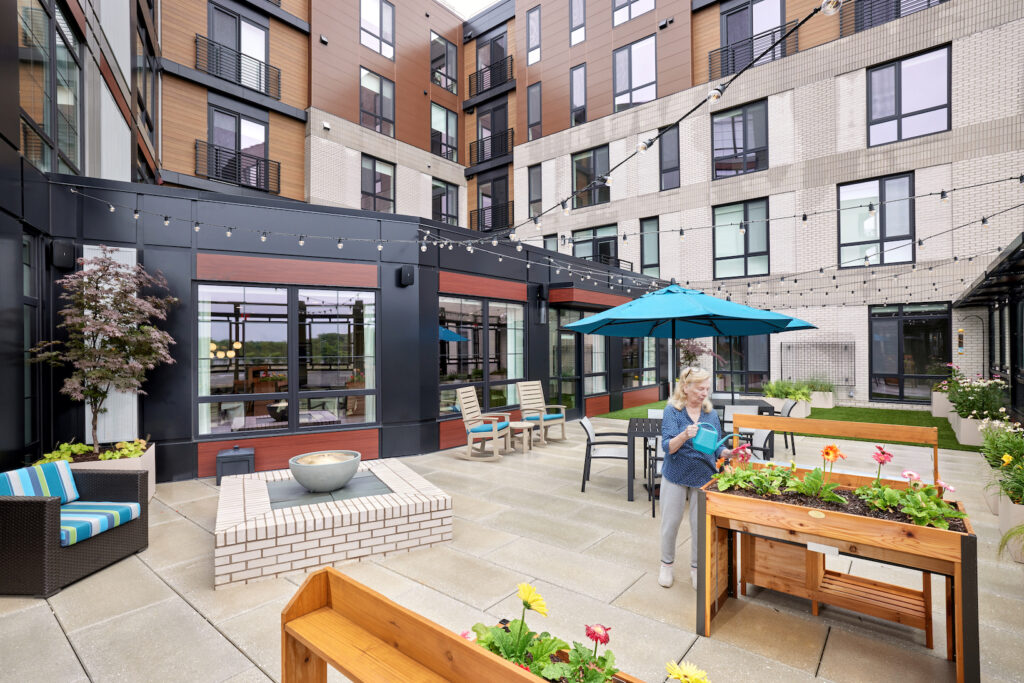By: Courtney Ryan
For the last few years, the senior living industry has faced high construction costs and financing hurdles, slowing the development of new projects and communities. The memory care sector has been no exception.
In the past, many operators would use each new community as a new blueprint for evolution or innovation. Given the slow rate of new construction, memory care companies are still achieving that through campus redevelopment and repositioning.
In particular, memory care communities are embracing new technology and design innovations to support meaningful human interactions. From recent projects that draw inspiration from the dementia village model to added support for new technology, here are three current trends that memory care architects and designers say are taking center stage in the way new projects are coming together:
Small home communities — security without confinement
In the past, memory care living spaces have been relegated to highly secure wings within locked senior living communities. That has begun to change in recent years as operators and architects take cues from concepts like the Hogeweyk dementia village in Weesp, Netherlands.
Recent examples of that trend include projects from Lutheran Senior Services and Willow Valley Communities. And while these projects are tough to do and relatively rare, operators are drawn to them given their innovative qualities
“It’s an industry and sector that is very cautious – and rightly, so since they’re being charged with keeping people safe, happy and healthy,” said Max Winters, senior designer at RLPS Architects. “But there is a collective questioning right now of whether separating people is best for people living in those spaces and for their loved ones.”
Winters and RLPS recently completed a campus in Southington, Connecticut, for operator LiveWell. The campus is a residential community where people with dementia can move freely between social and private spaces, similar to at Hogeweyk.
“The traditional institutional memory care model says that we’re just building you one box and everything has to happen within that box,” he said, explaining that the LiveWell campus more accurately mirrors daily life outside of memory care spaces. “We’re starting to see more environments where people can have different kinds of experiences and social interactions that are actually separate from their private spaces.”
Canadian architect Bill Mitchell, a partner at Zeidler Architecture, toured Hogeweyk and incorporated its open movement philosophy into the design at Bethany Care Society’s forthcoming redevelopment in Alberta, Canada.
“At Hogeweyk, it was difficult for us to distinguish who was a resident and who was a care provider until we spent more time there,” said Mitchell. “So we’re trying to bring that same level of autonomy where people can move outside their homes, doors aren’t necessarily locked, and they can meet with other residents.”
This small-home model reimagines senior living communities as “neighborhoods,” where residents live in a private space and move freely between community areas. At Bethany’s community in Calgary, these areas are actually whole floors designated for activities like music, gardening, sports and playing games.
“We’re designing facilities that we want to live in,” said Mitchell. “We understand all the specific requirements that need to be in place, but we don’t want it to feel like you’re living in a hospital.”
Winters said that even subtle touches like adding a wine fridge to the kitchen at LiveWell go a long way in establishing normalcy. “Part of that is just about removing the idea that you have to downgrade your lifestyle and your living experience just because your brain is changing,” he said.
Technology to support meaningful human interaction
Memory care communities have sometimes been conservative in implementing new technology given privacy concerns and the overall cost of modernizing. But in 2024, many more are finding that doing so can address safety concerns and help staff spend their time more meaningfully.
Memory care operators are building infrastructure for AI-powered solutions such as fall prevention sensors, circadian rhythm lighting and timed door locking mechanisms that can be useful without invading residents’ privacy.
“There are sensitive ways to keep track of and monitor residents and deemphasize the physical barriers without putting them behind closed doors in a separate area,” said Cynthia Shonaiya, a principal at Hord Coplan Macht. She also explained that tools such as Alexa and Google Voice can free staff from running between residents throughout their shift.
“People with memory issues tend to ask questions over and over again,” she said. “So being able to have those tools to provide quick responses can reduce anxiety and allow staff to have more in-depth interactions with residents.”
Shonaiya believes that by obscuring ways to exit buildings as opposed to just locking doors will eliminate frustration points and utilize design in a way that is more empathetic.
“I think design will continue to evolve how we can support residents and their families and caregivers in a way that is less about restrictions, but more about enhancing their experience and the experience of those around them,” she said.
 Memory care garden at Brightview Dulles Corner in Herndon, Va.; Photo by Garrett Rowland Memory care garden at Brightview Dulles Corner in Herndon, Va.; Photo by Garrett Rowland
Memory care garden at Brightview Dulles Corner in Herndon, Va.; Photo by Garrett Rowland Memory care garden at Brightview Dulles Corner in Herndon, Va.; Photo by Garrett RowlandRedevelopment to meet growing demand
The demand for memory care has grown in recent years, and that trend is expected to continue in 2025 and beyond as more older adults need specialized memory care.
But new construction and development is costly and still hard to accomplish, which is why many communities are opting to redevelop and renovate existing spaces to meet this demand.
“At the end of the day, there is definitely an overall question of how many people are going to have dementia in the next 20 years versus how many of them can afford care,” said Winters. “So those renovations are really crucial to at least an additional group of people who won’t otherwise be able to afford it.”
Shonaiya said that even when launching new construction, operators are considering future memory care conversion needs.
“A lot of operators are asking us to design assisted living and even independent living in such a way that it can be licensed for assisted living or memory care in the future so that people don’t necessarily have to downsize into a small place,” she said. “Memory care apartments are actually beginning to look more like assisted living or even small independent living units.”


